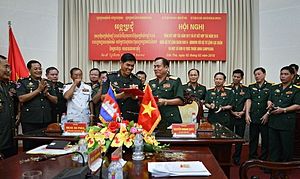Late last month, Vietnam and Cambodia held a review meeting to evaluate the state of joint naval patrols that they had been conducting. The engagement highlighted one facet of the broader bilateral defense relationship between the two neighboring Southeast Asian states that they continue to develop over time as they manage other related opportunities and challenges.
Vietnam and Cambodia, two neighboring Southeast Asian states, share a broad defense relationship as part of their wider diplomatic ties. Vietnam provides the Royal Cambodian Armed Forces (RCAF) with military equipment, infrastructure, and training, while both countries have also looked to manage more sensitive areas of the relationship such as outstanding issues over their shared 700-mile long border, illegal fishing, and China’s growing influence in mainland Southeast Asia.
One facet of the defense aspect of the relationship is the holding of Vietnam-Cambodia joint patrols. The patrols, focused on areas such as search and rescue and communication, are designed in order to build trust and cooperation and improve the level of coordination in the wake of joint maritime challenges both sides face such as illegal fishing. These joint patrols have become a regular feature of the relationship and are held every few months.
Late last month, this aspect of the Vietnam-Cambodia defense relationship was in the headlines with the holding of a review conference on joint patrols. The 28th joint conference was held between the two countries to review the 55th and 56th joint patrols between the Naval Region 5 Command of the Vietnam People’s Navy and the Ream Naval Base of the Royal Cambodian Navy took place on December 25 in Phu Quoc island district, Kien Giang province, and the meeting was chaired by Rear Admiral Nguyen Duy Ty, Chief of the Naval Region 5 Command, and General Ouk SeyHa, Deputy Naval Chief and Commander of the Cambodian Ream Naval Base.
According to the official account by Vietnam’s defense ministry, during the meeting, the two sides reviewed the coordination between the two sides in conducting the joint patrols, including the outcomes of the 55th and 56th patrols. They also discussed various aspects of this, including the role of the patrols in promoting security in overlapping and shared waters, the improvements in operational capability of crewmembers and the performance of the permanent office of joint patrols on each side, and the extent to which fishermen and vessels were observing fishing regulations.
Unsurprisingly, few additional details were publicly disclosed regarding the private deliberations between the two sides beyond the items of discussion and the signing of a memorandum of understanding on cooperation. And while the defense ministry’s account noted that both sides had discussed “issues of common concern,” no additional details were provided. Nonetheless, as both sides continue to manage their wider defense relationship, one can expect that this will continue to be one facet to keep an eye on in the coming years.
































